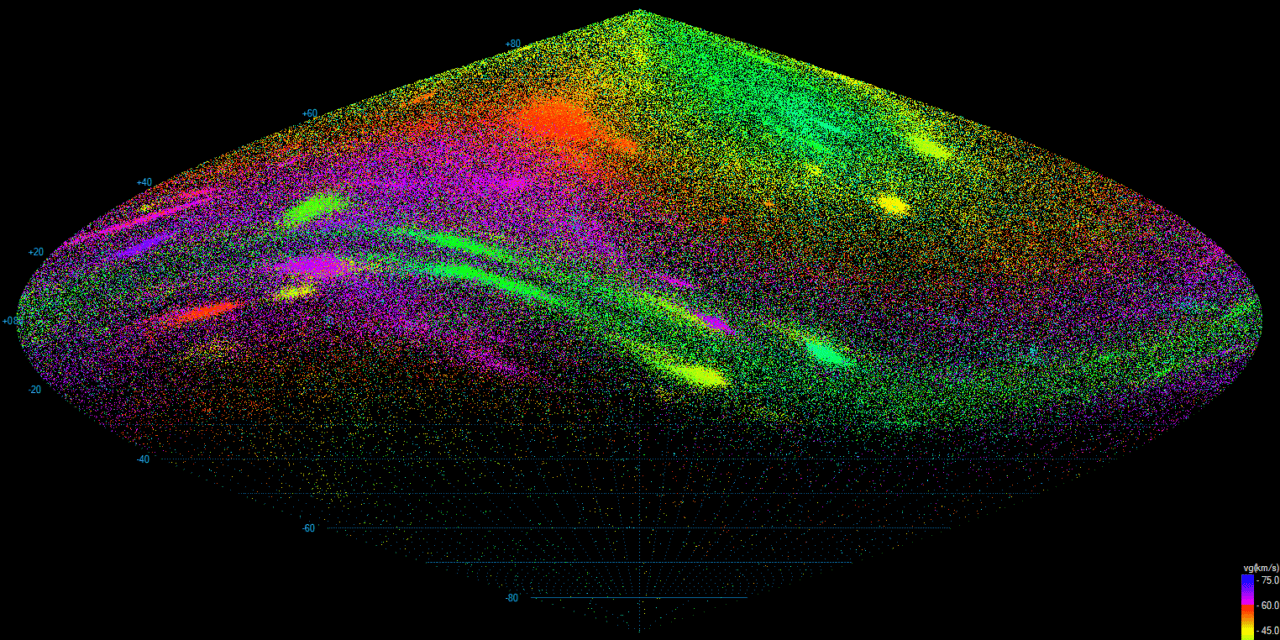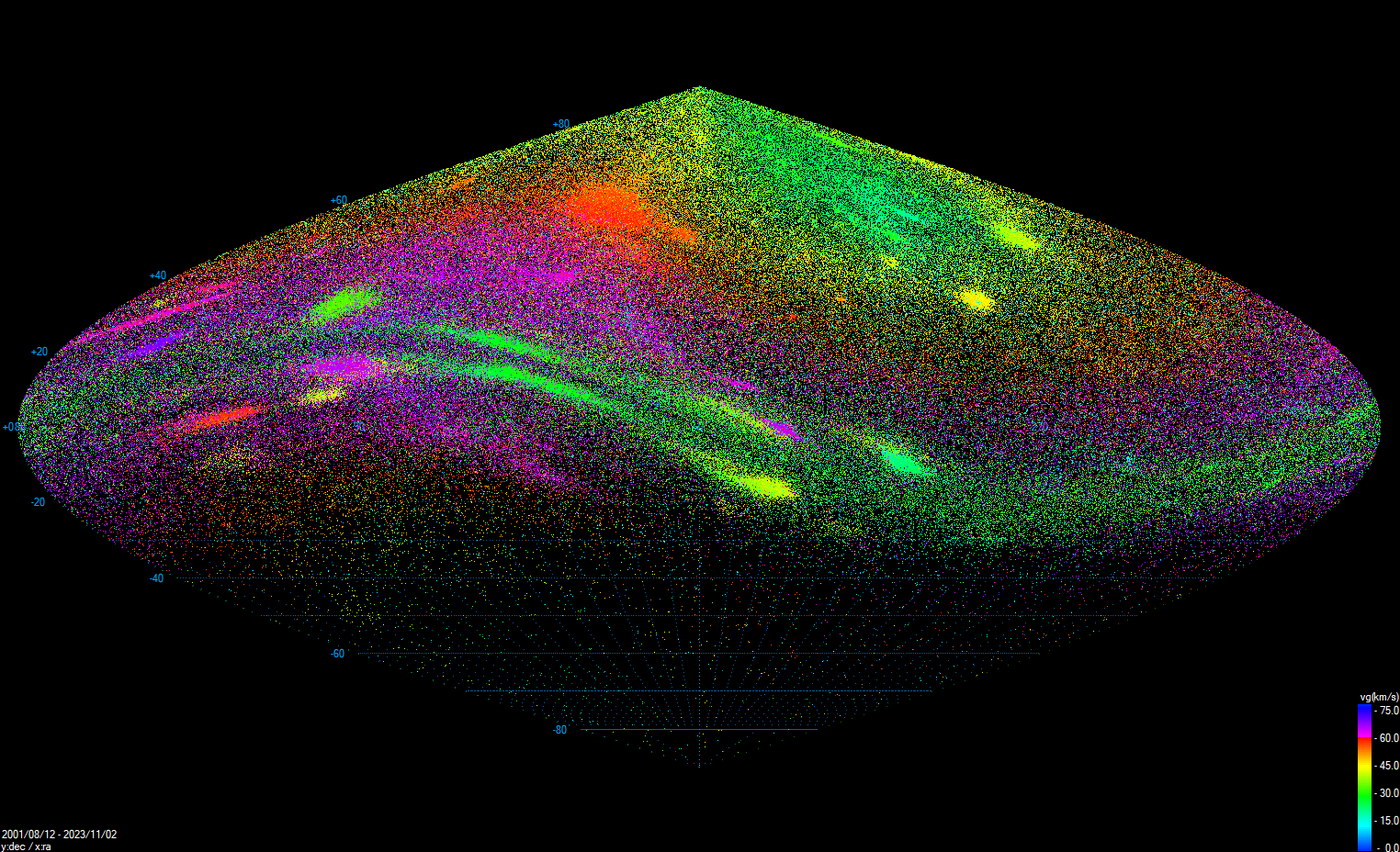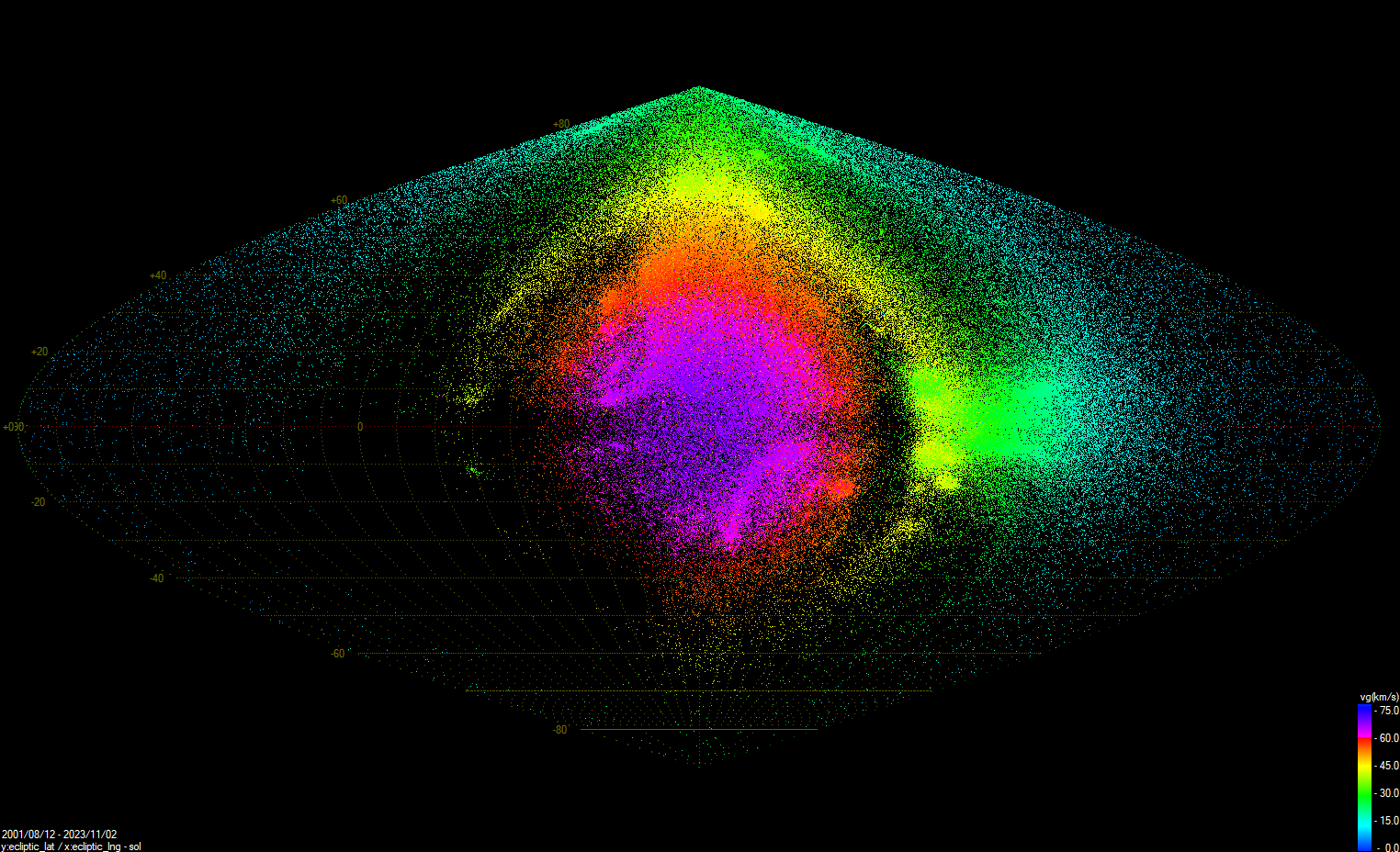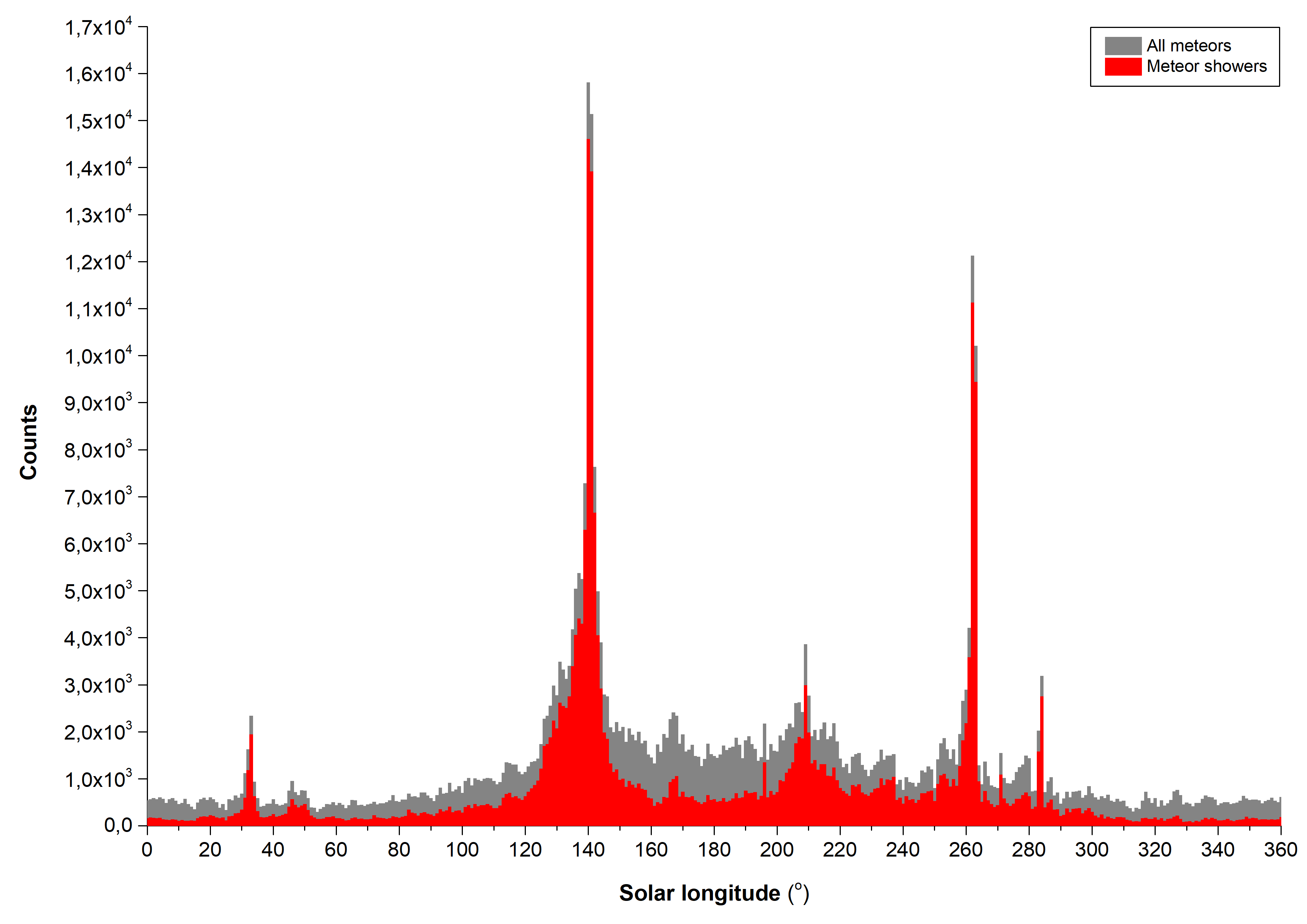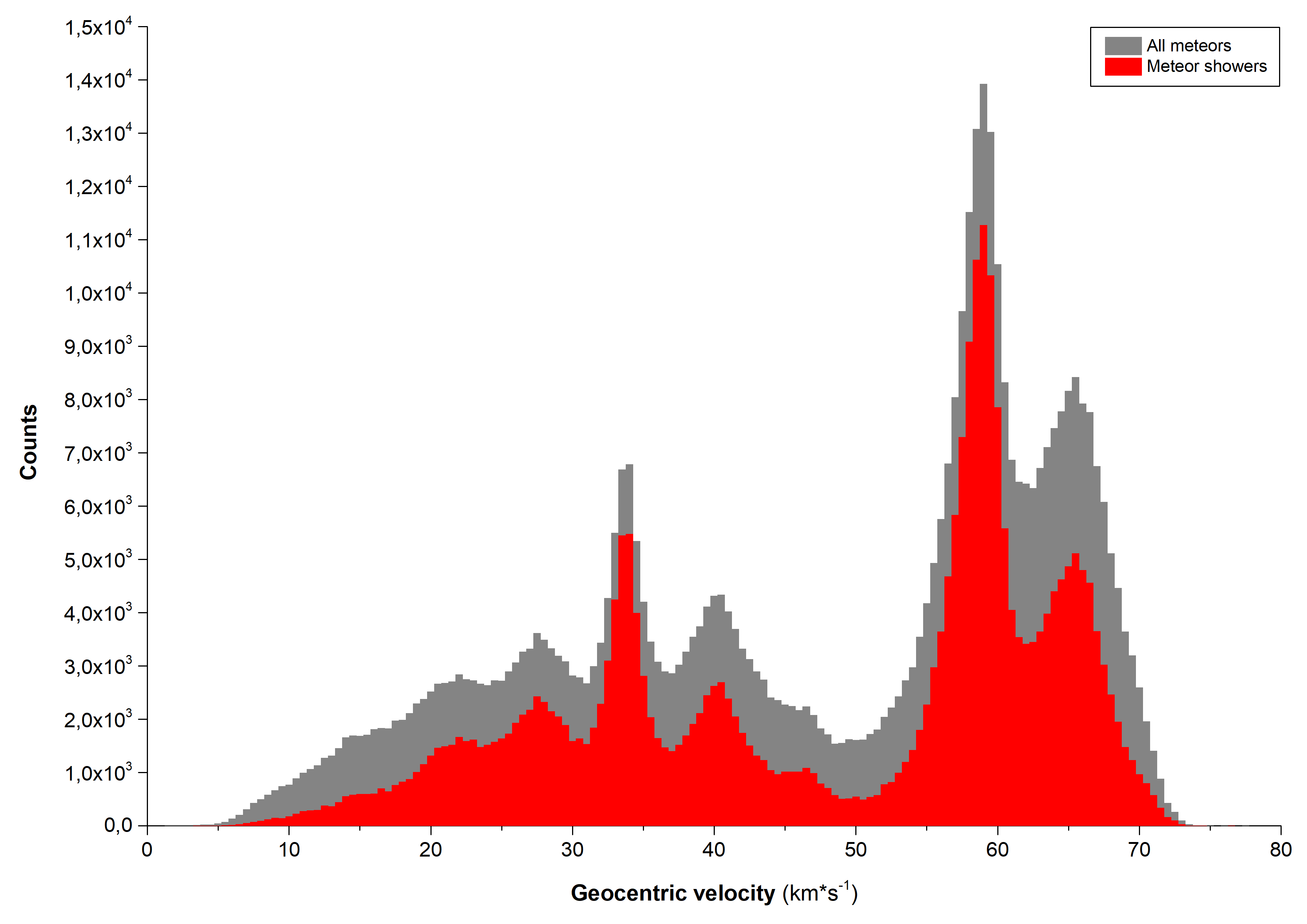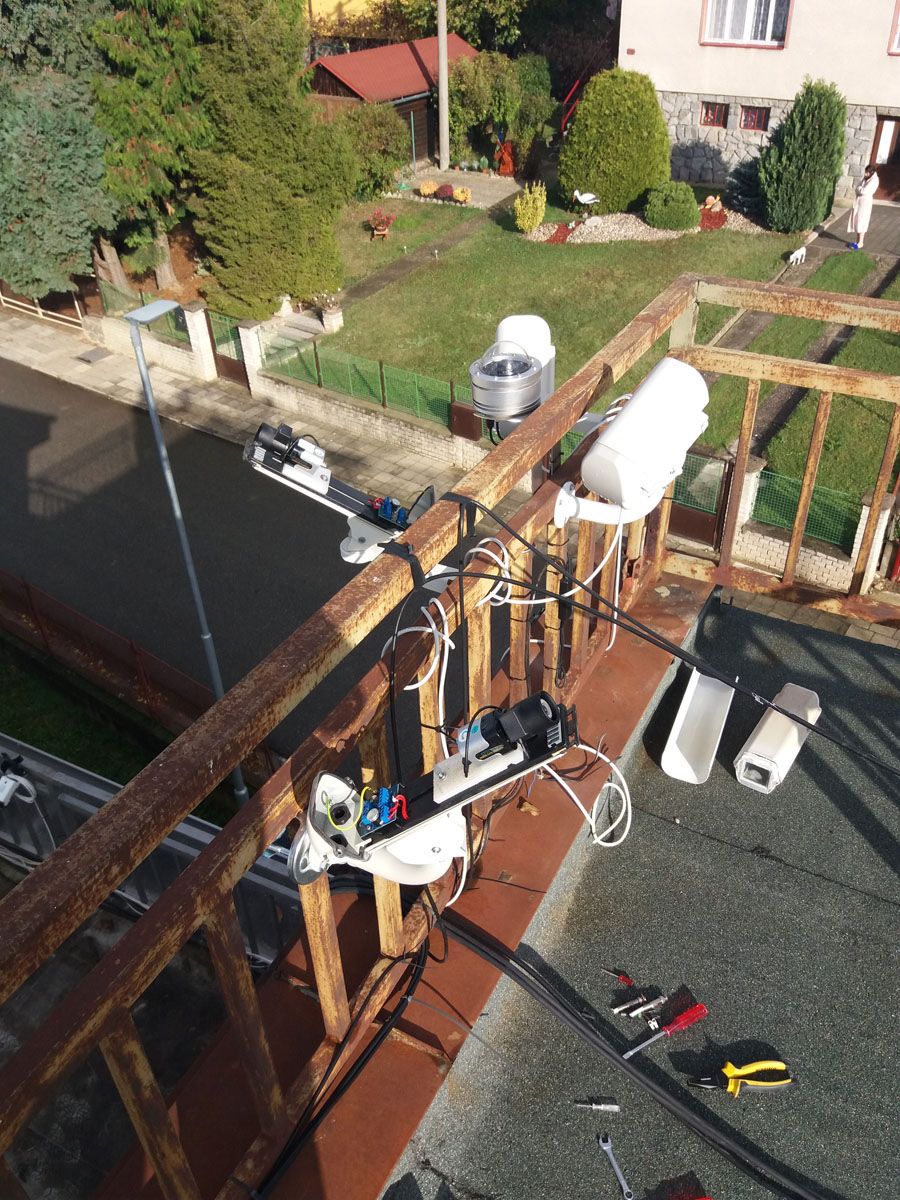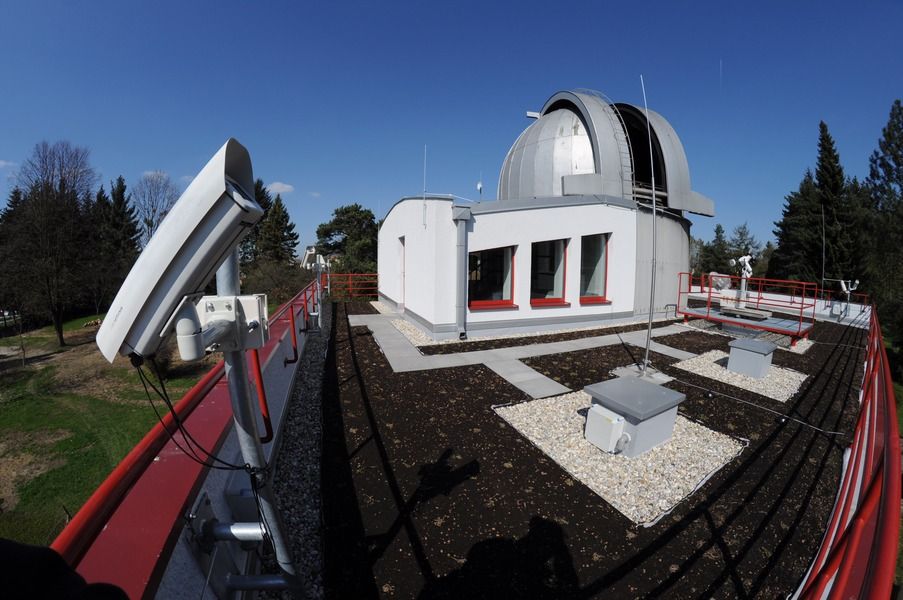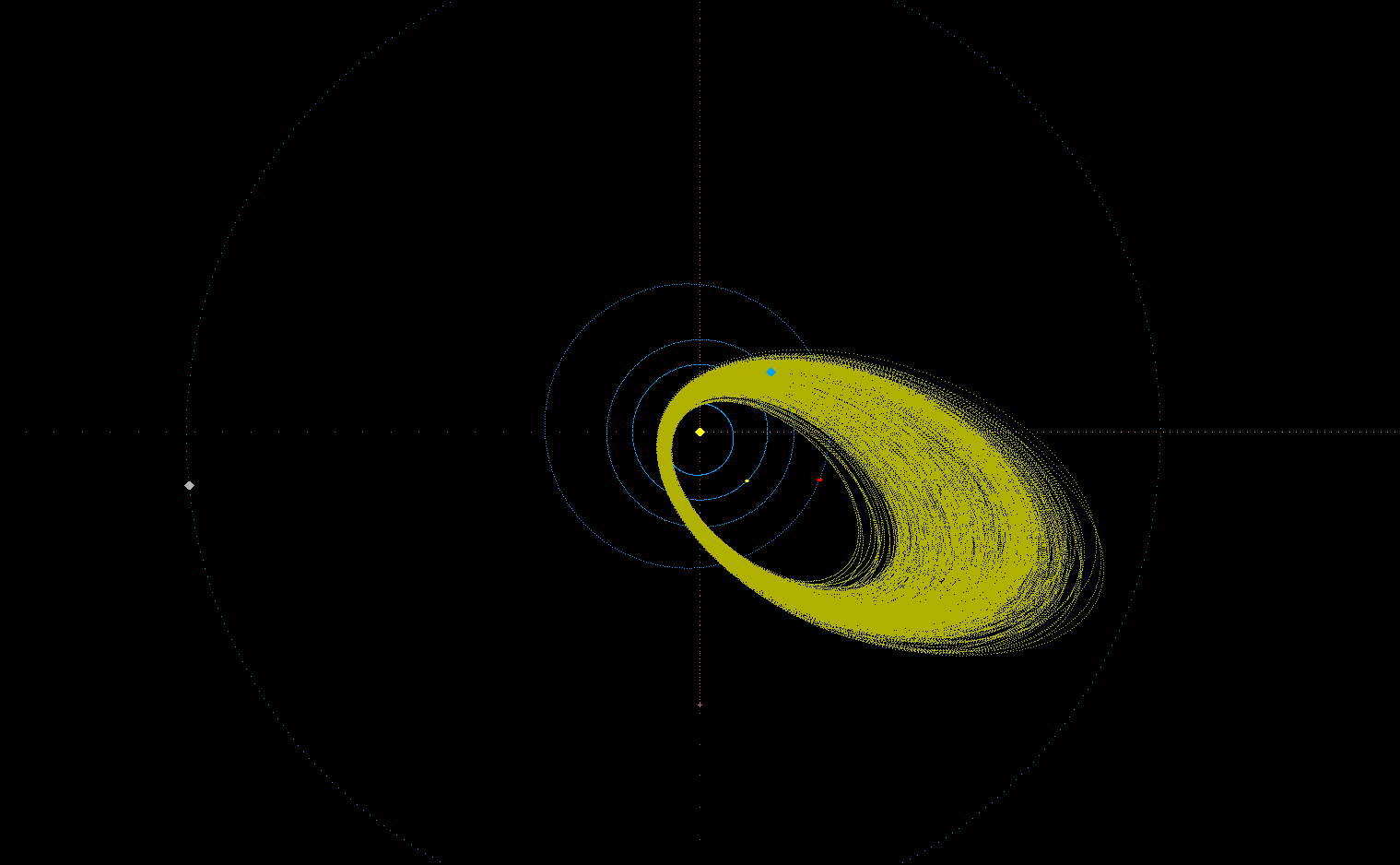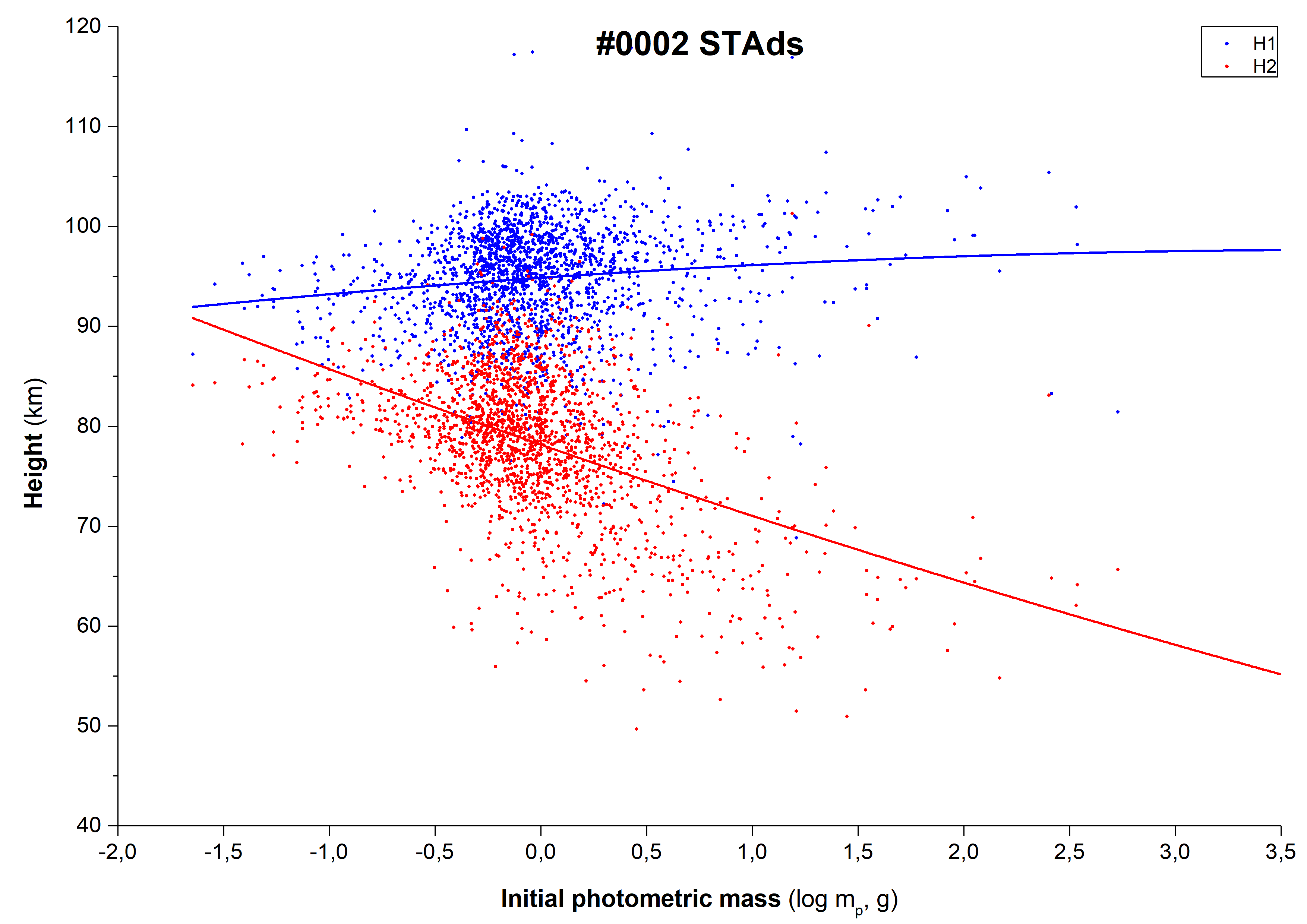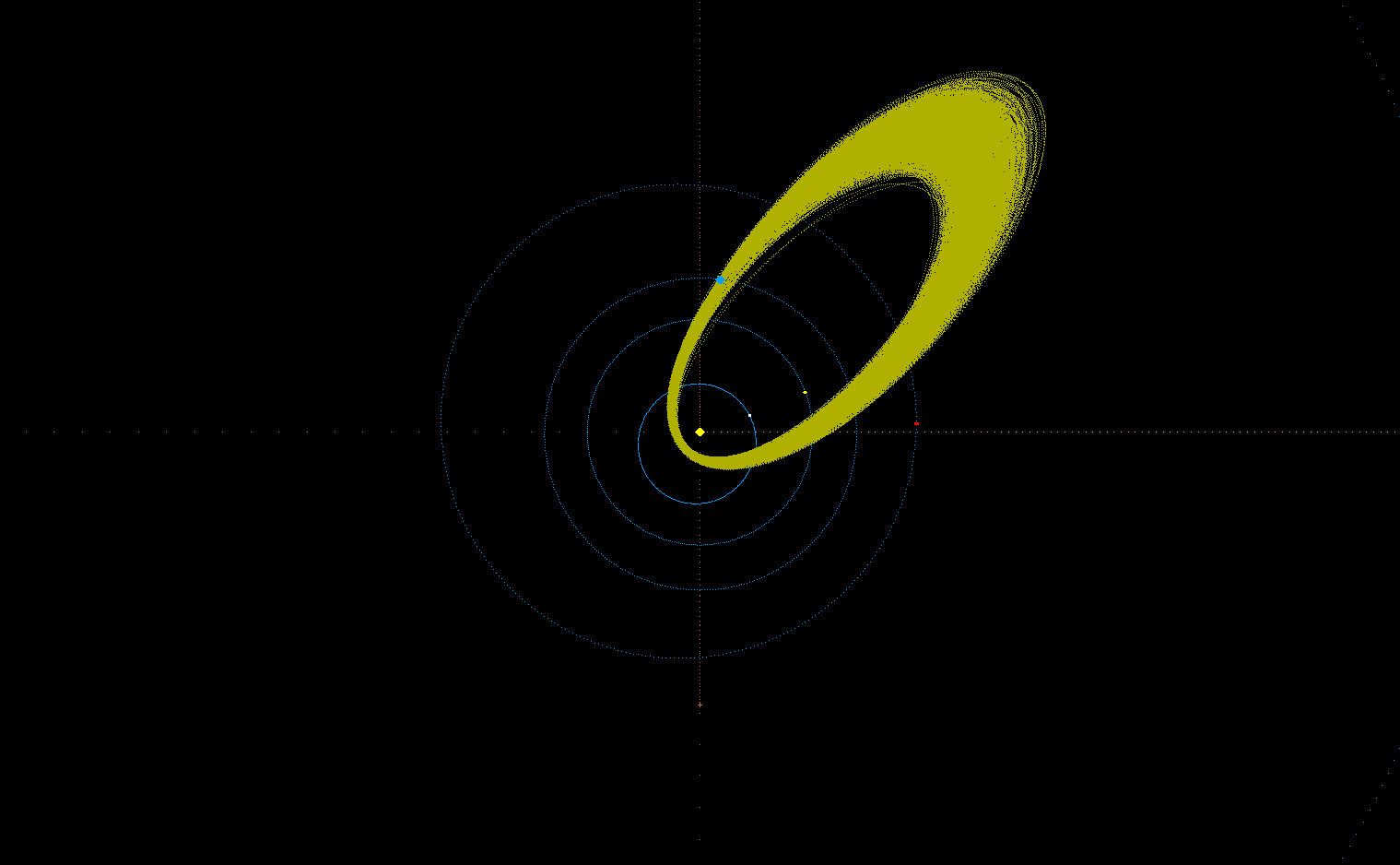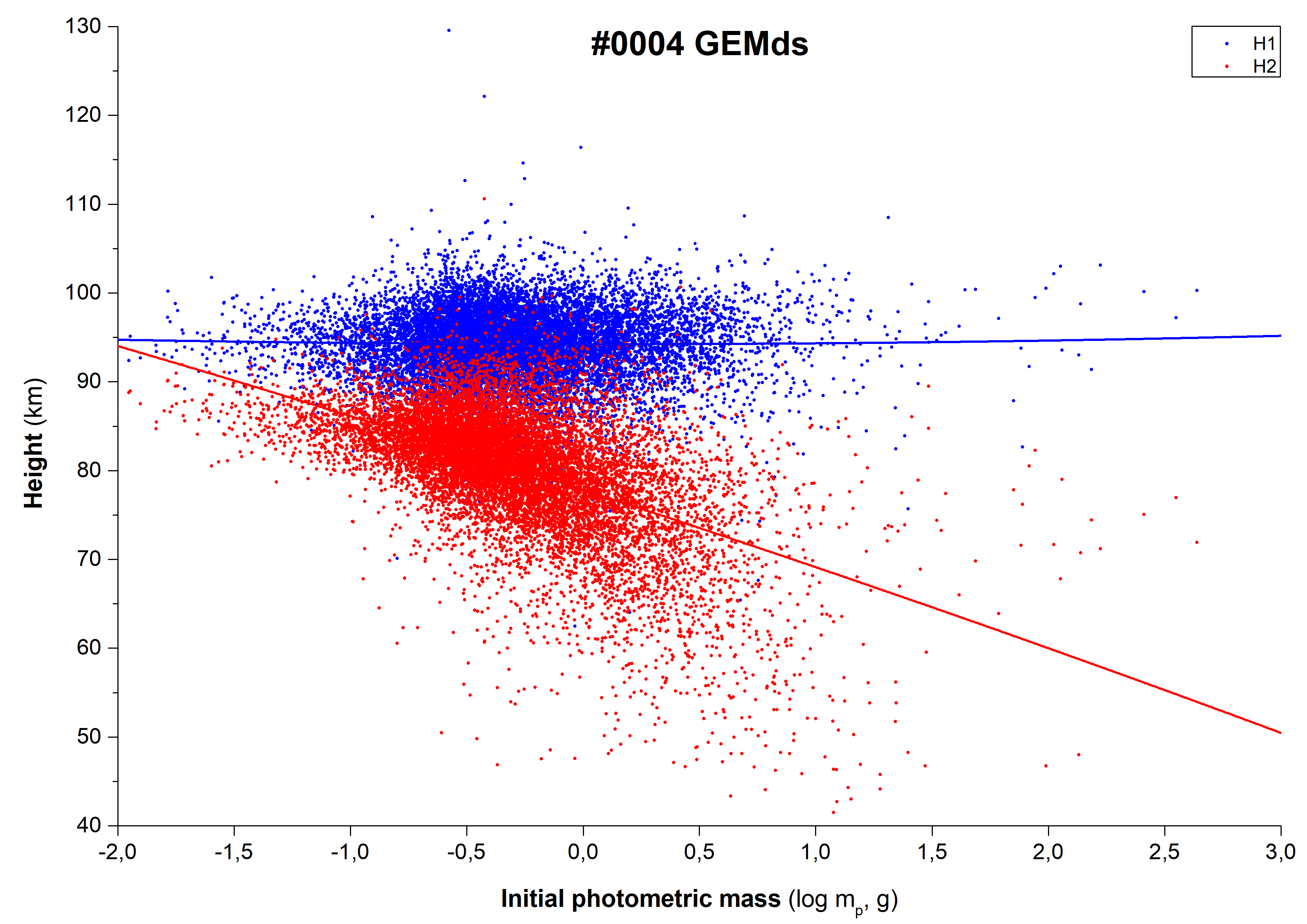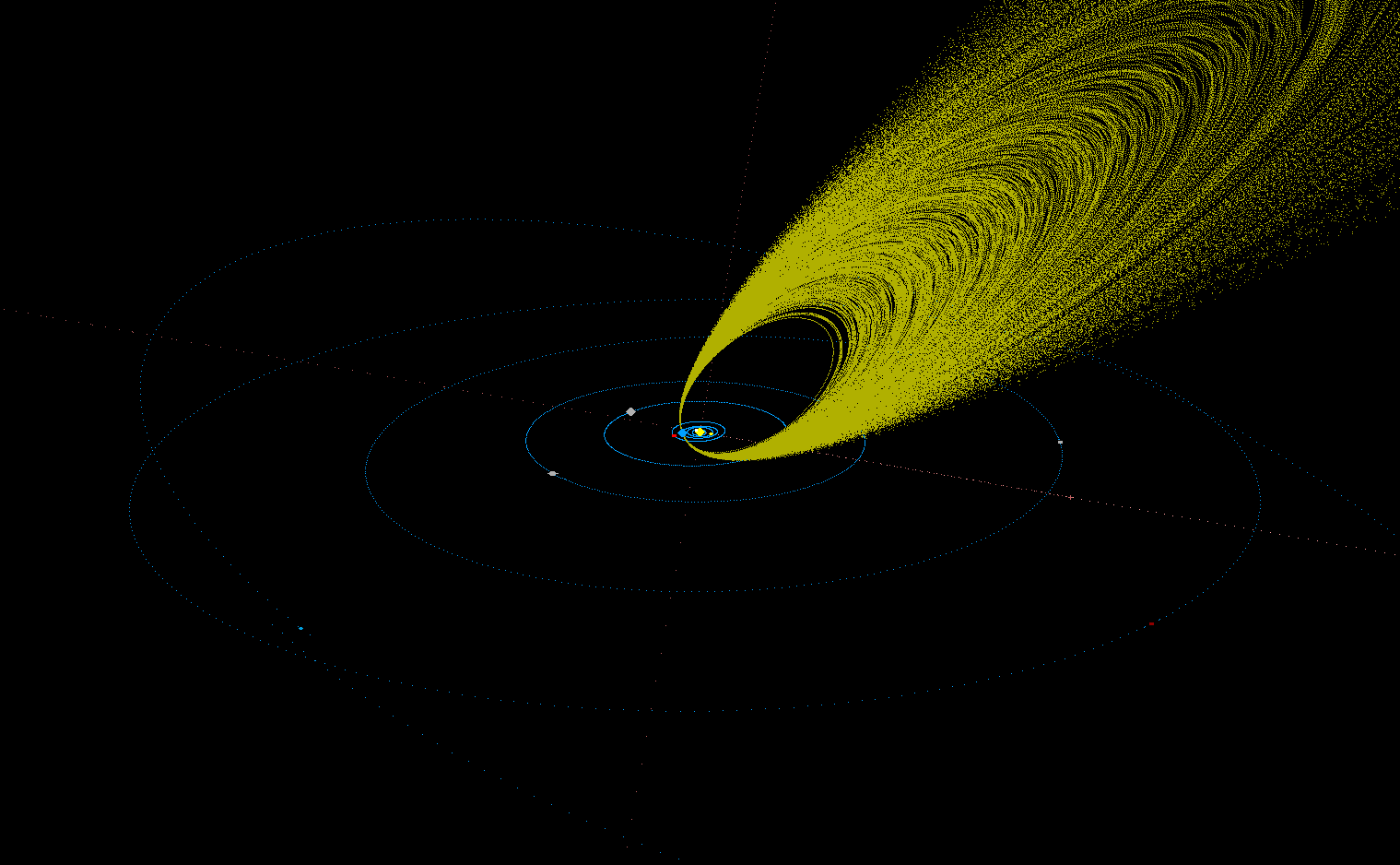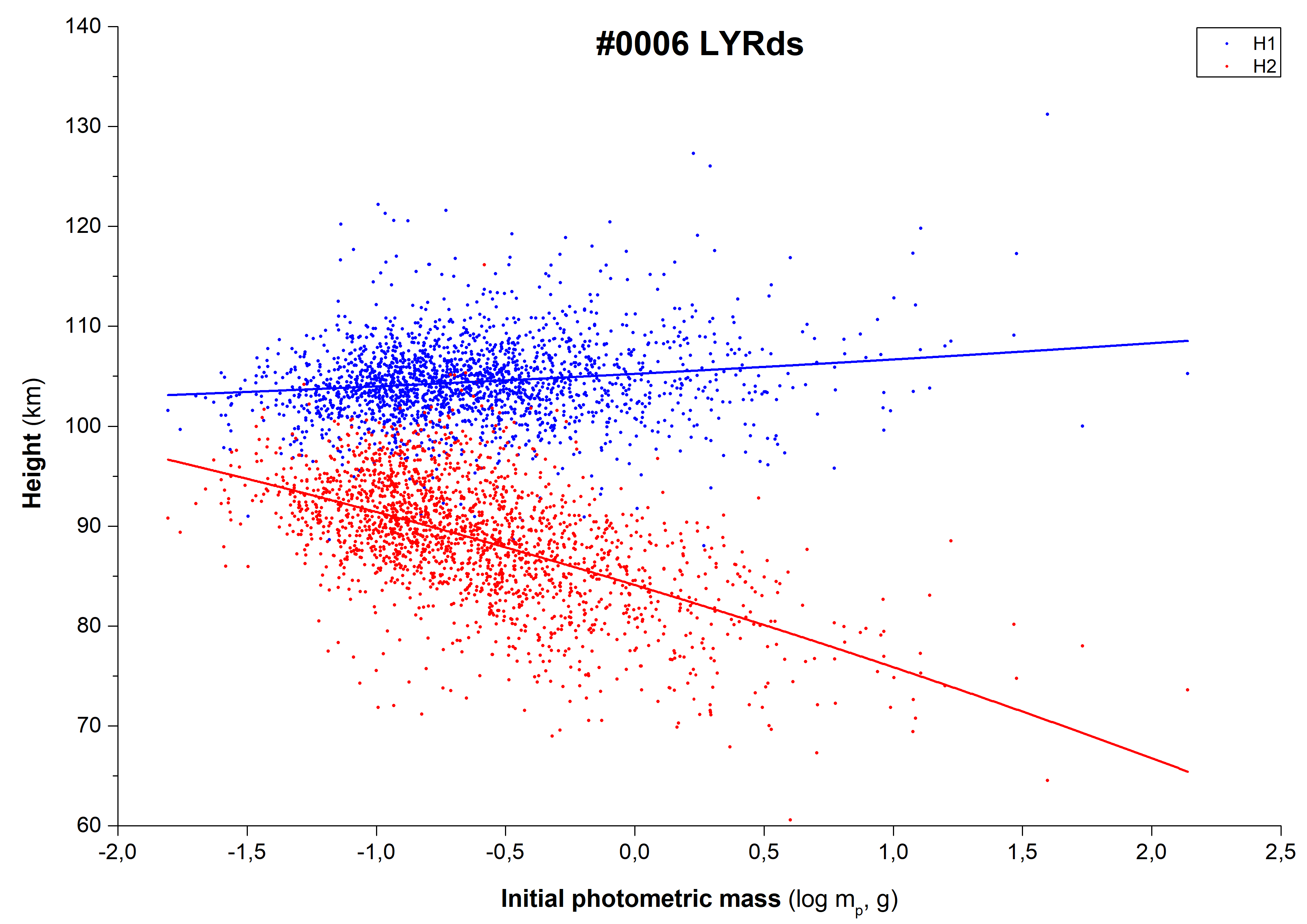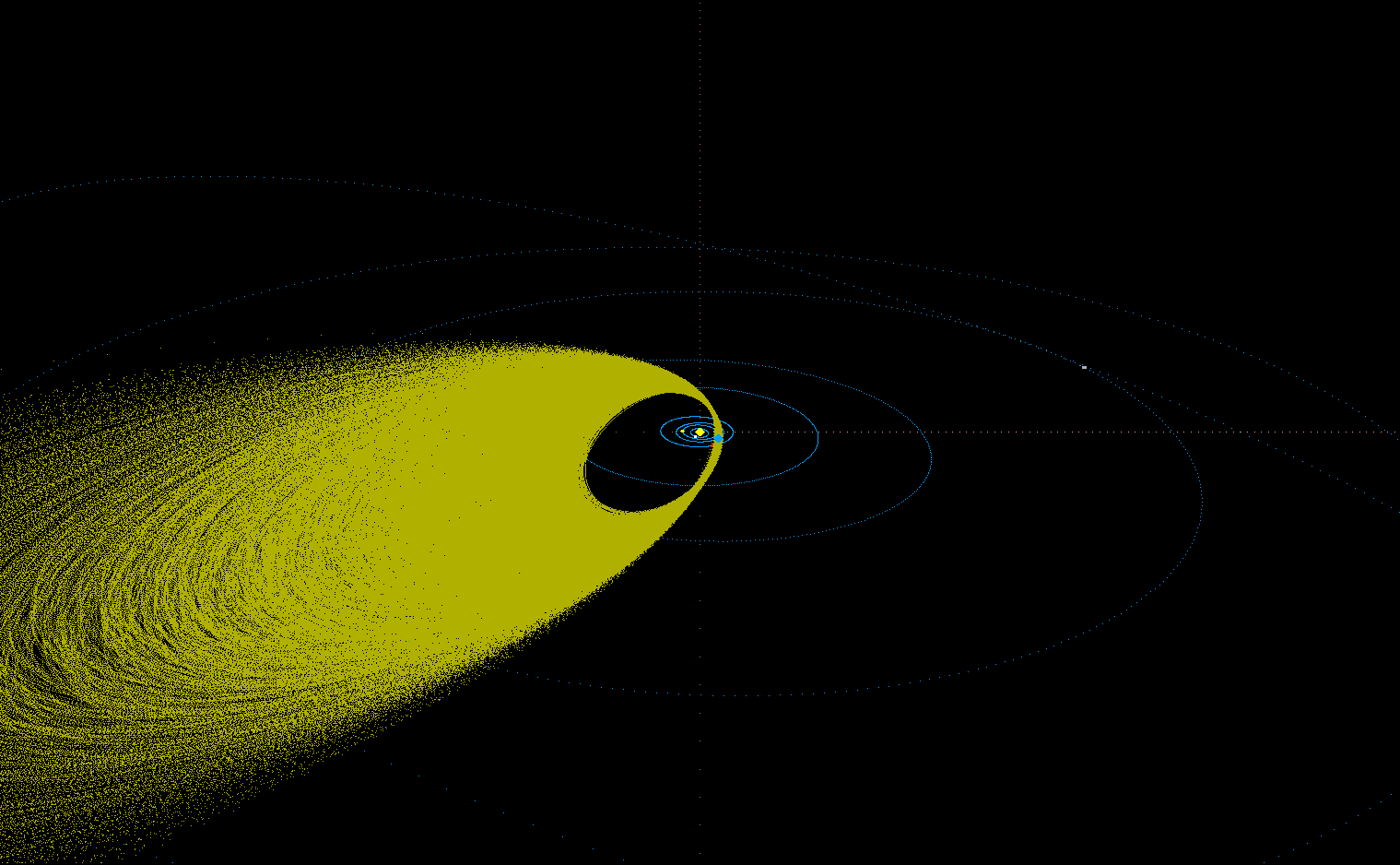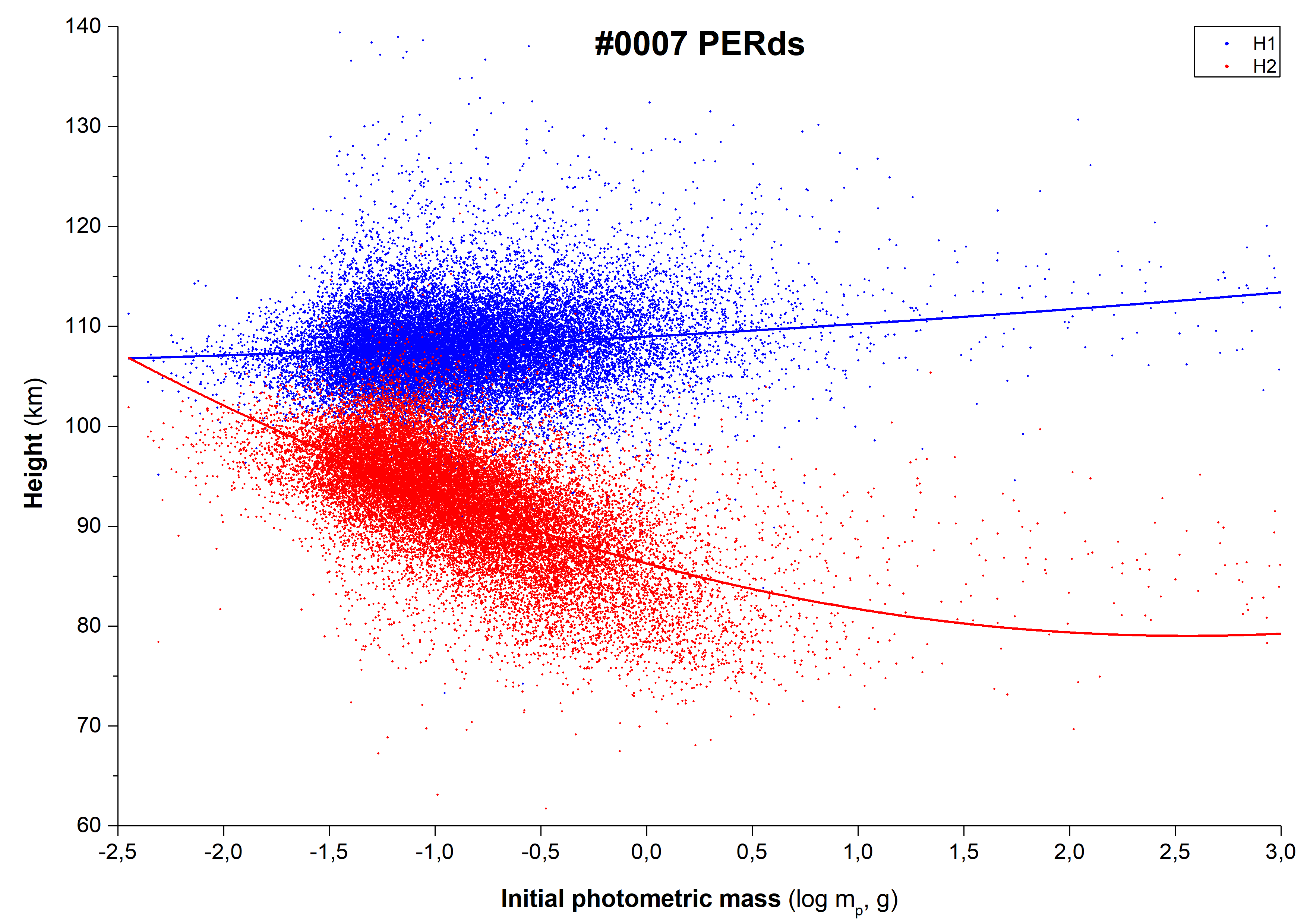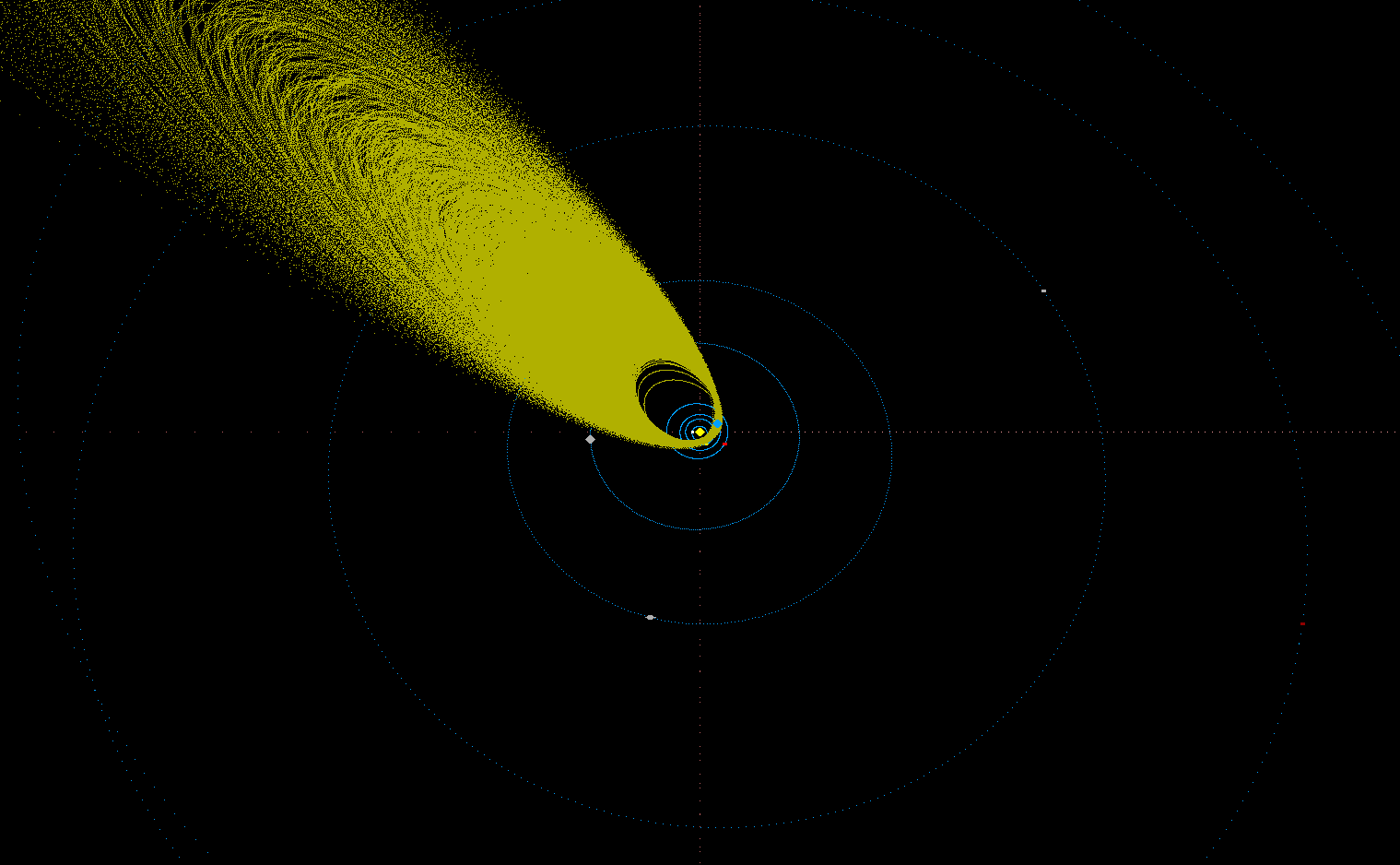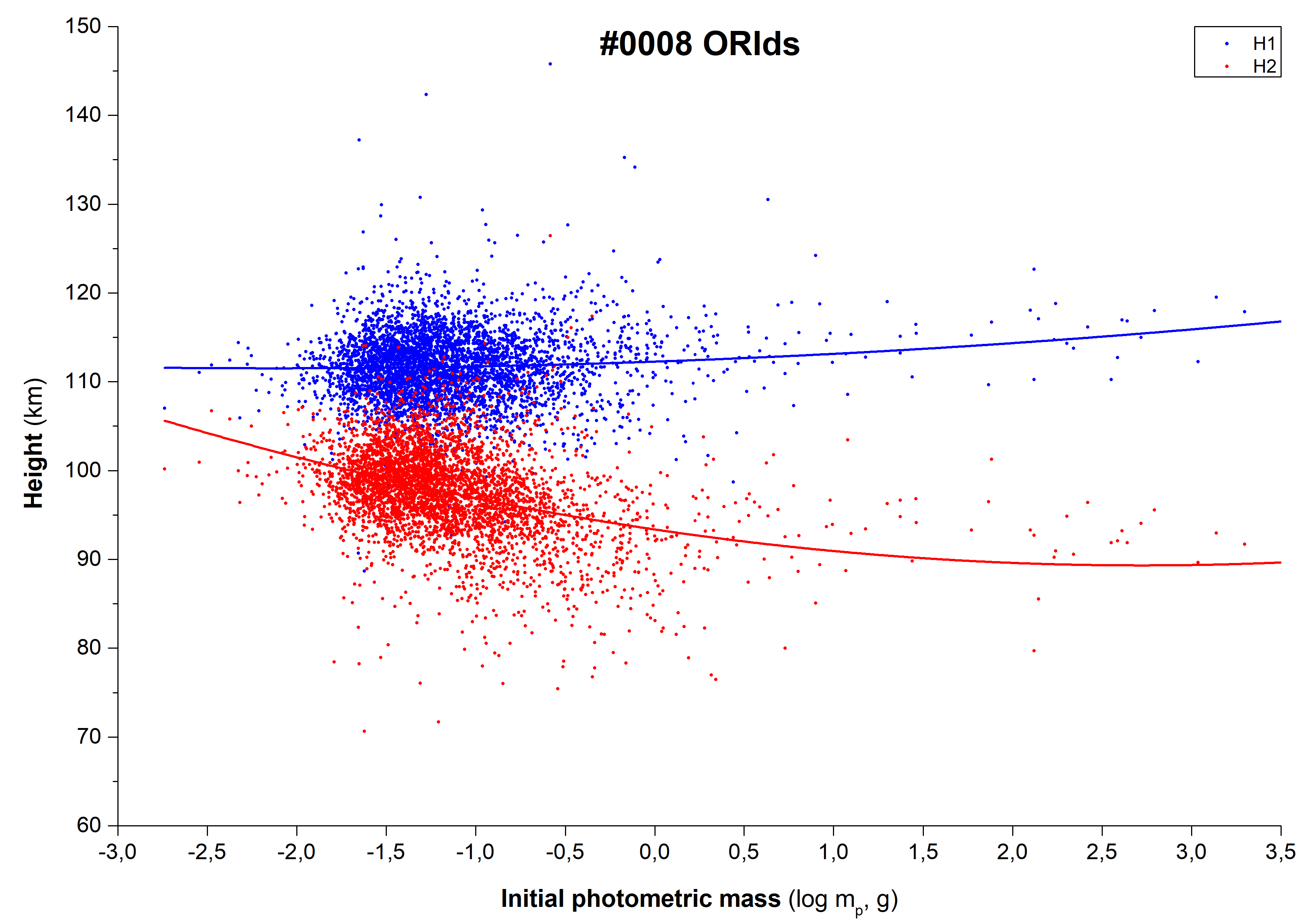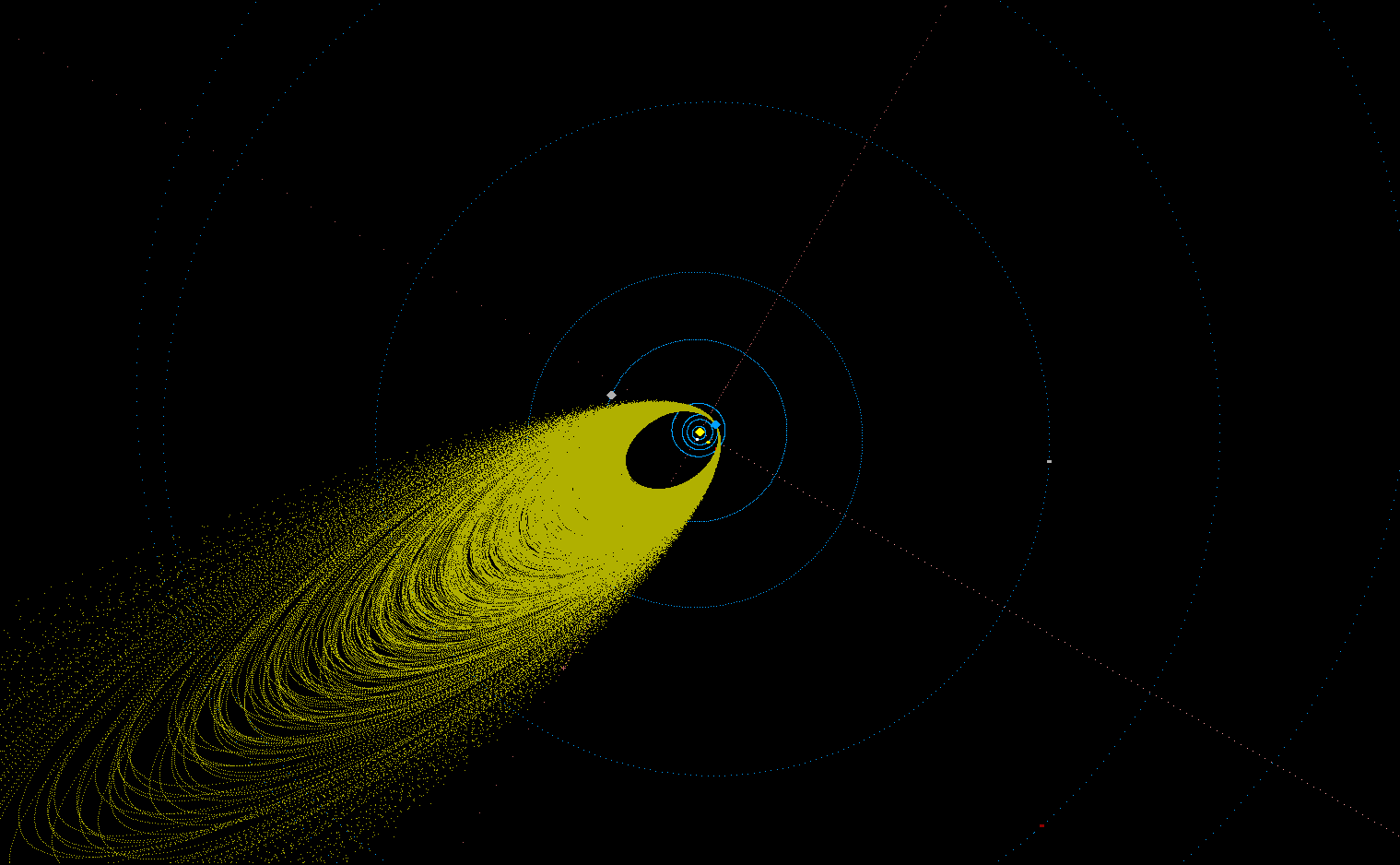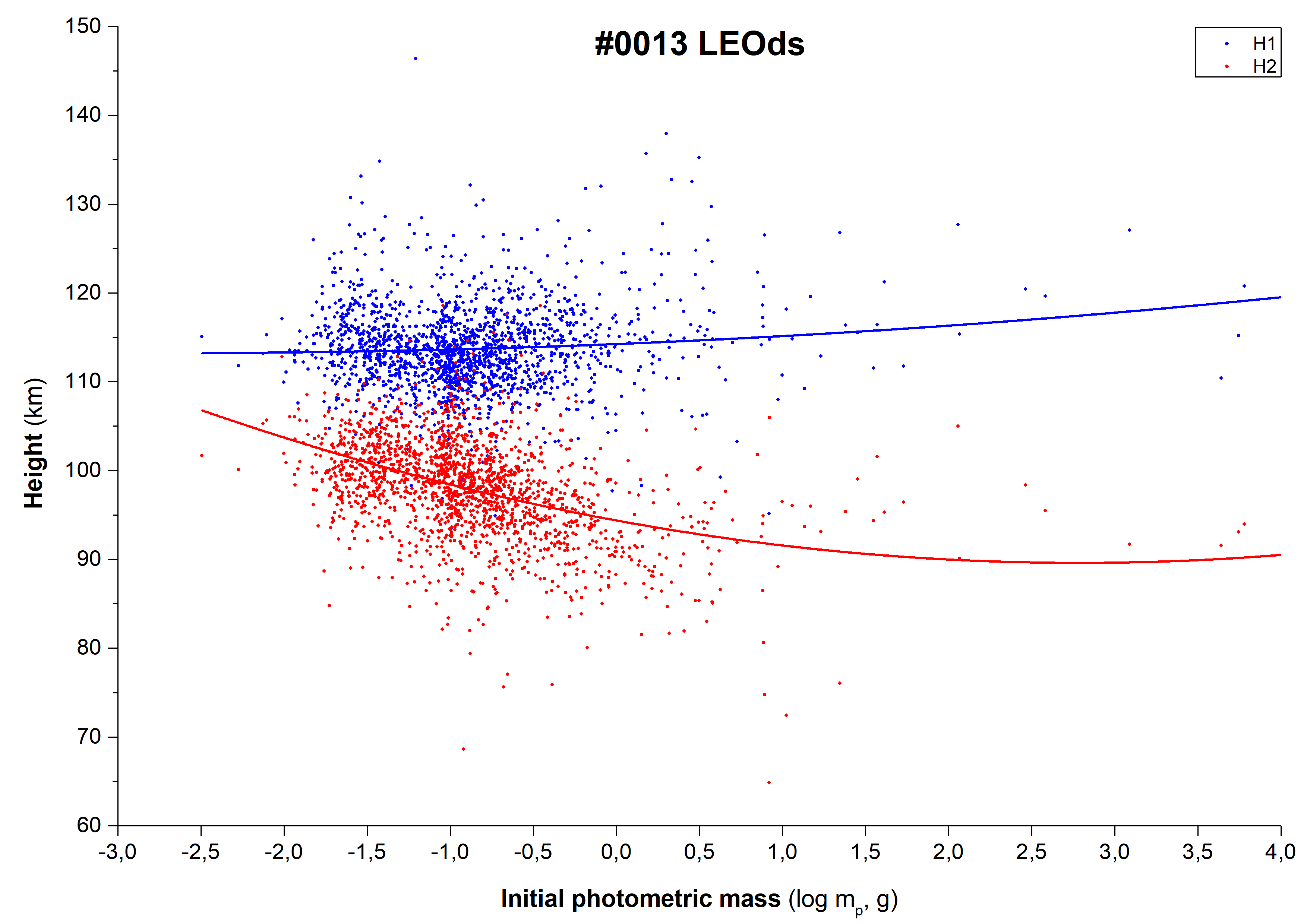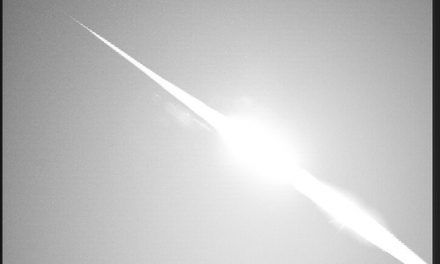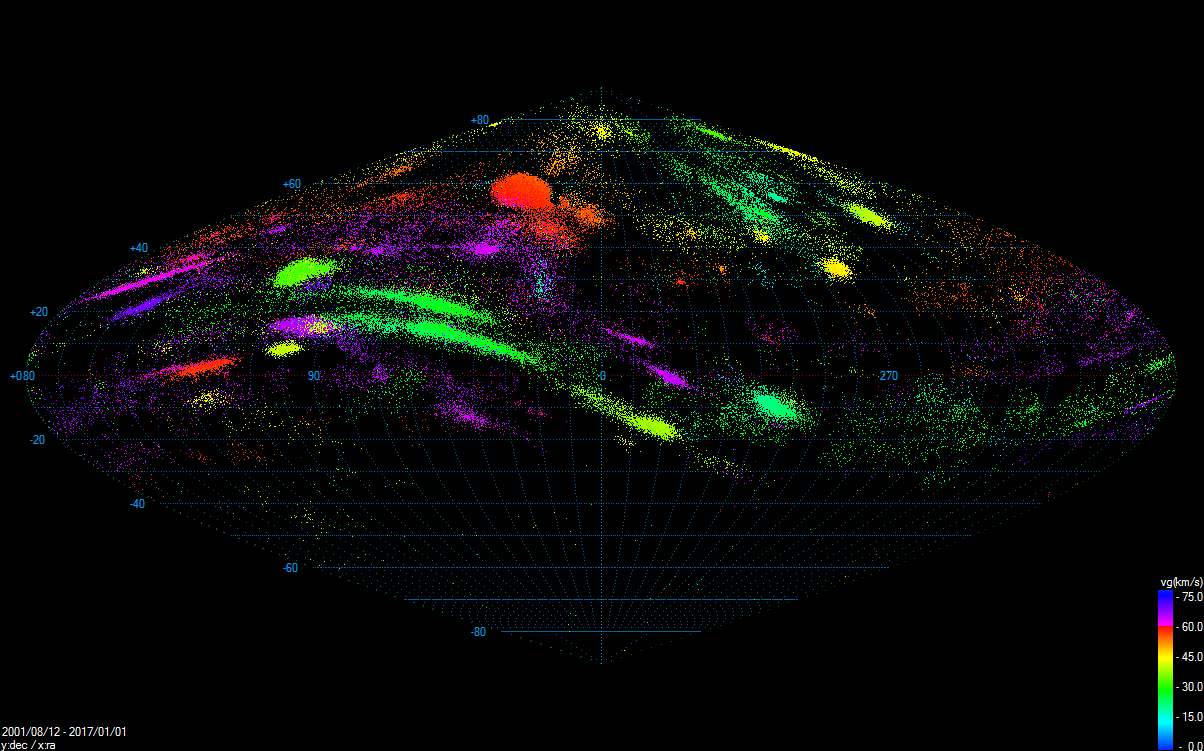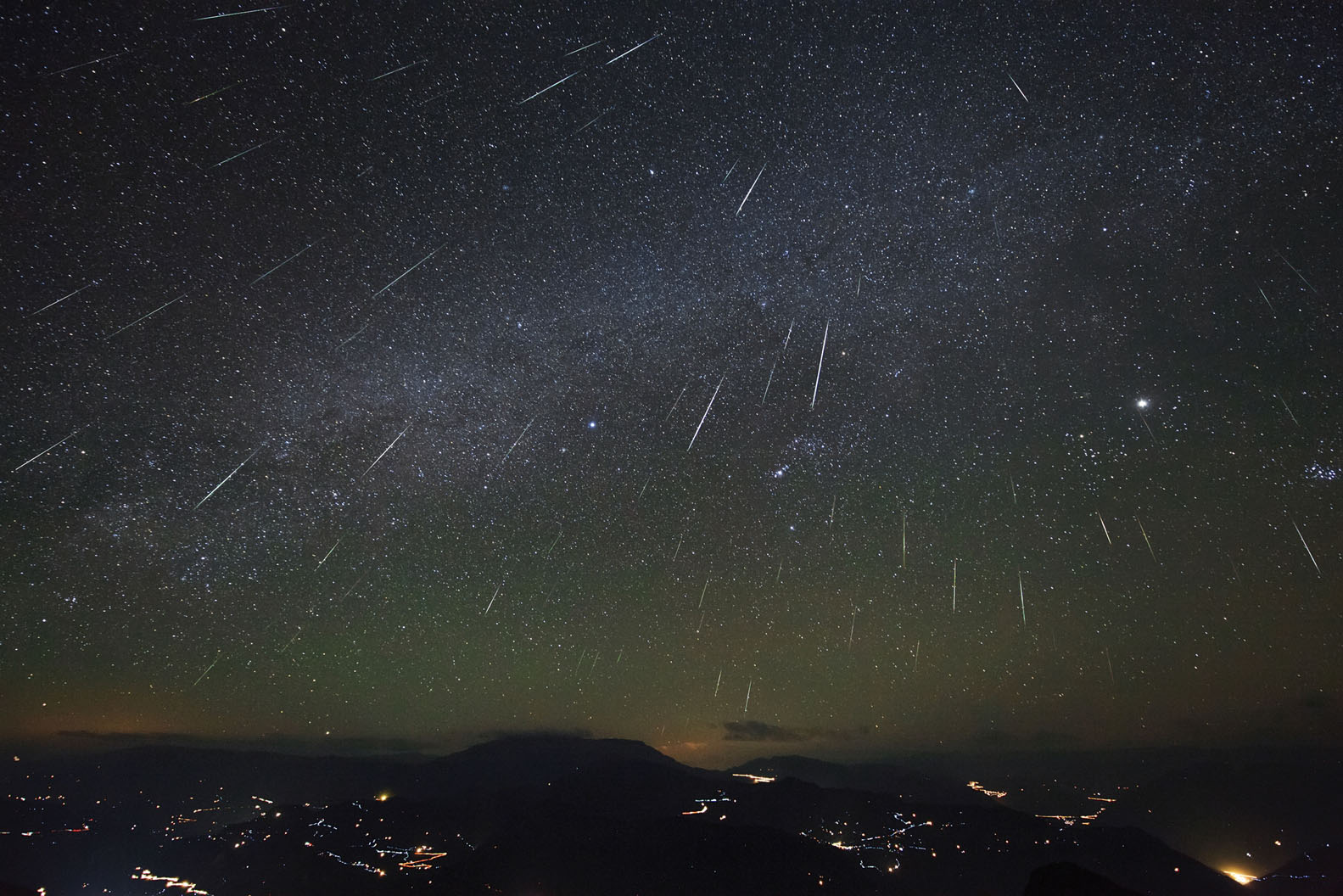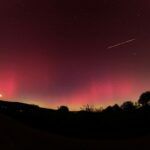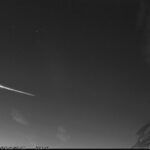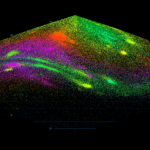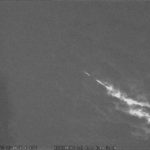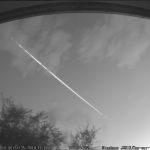Jakub Koukal¹, Jiří Srba¹, Libor Lenža¹
¹ Valašské Meziříčí Observatory, Vsetínská 78, CZ75701 Valašské Meziříčí, Czech Republic
jkoukal@astrovm.cz, libor.lenza@astrovm.cz
EDMOND (European viDeoMeteOr Network Database) is a database of meteor orbits that aggregates video data from observations of meteors from 15 independent national networks and 2 multinational databases. These networks and databases employ different methods and systems for detecting meteors as well as calculating their orbits. EDMOND v5.05 is the fifth version of the database, containing continuous video meteor data from the year 2000 to 2023. The database’s goal is to continuously collect video data and ensure continuity with respect to upcoming new systems for recording video meteors. Currently, the database has compiled data on 7 462 700 single-station meteors, creating 978 006 orbits. After reduction using the applied criteria, EDMOND v5.05 contains a total of 480 190 orbits of multi-station meteors.
EDMOND DATABASE
The use of video technology for monitoring and recording meteors began in the 1970s and has since undergone rapid development. Although initially the domain of professional astronomers, amateur observers, especially in Japan and the Netherlands, started developing systems suitable for amateur conditions in the 1980s. Subsequent development of amateur observation stations continued at a fast pace, primarily in connection with the improvement and innovation of CCD or CMOS technology, and the increasing accessibility of this equipment to amateur astronomers.
Initially fragmented national networks or isolated observers in Europe, Australia, North America, and South America were consolidated into the centralized database of meteor orbits called EDMOND (European viDeoMeteOr Network Database), which was established in 2011 (Kornoš et al., 2013; Kornoš et al., 2014a,b).
| EDMOND DATABASE | |||||
| NETWORK ID | NETWORK NAME | STATE | BEG | END | SOFTWARE |
| BOAM | Base des Observateurs Amateurs de Metéores | France | 2010 | 2020 | UFO Capture |
| BosNet | Bosnian Network | Bosnia and Herzegovina | 2012 | 2014 | UFO Capture |
| BRAMON | BRAzilian MeteOr Network | Brazil | 2014 | 2017 | UFO Capture |
| CEMeNt | Central European Meteor Network | Czechia, Slovakia | 2009 | to present | UFO Capture |
| CMN | Croatian Meteor Network, Hrvatska Meteorska Mreza | Croatia | 2007 | 2011 | own |
| CSMON | Czech and Slovak Meteor Observation Network | Czechia, Slovakia | 2019 | to present | RMS |
| FMA | Fachgruppe Meteorastronomie | Switzerland | 2014 | to present | UFO Capture |
| HMN | Hungary Meteor Network, Magyar Hullócsillagok Egyesulet | Hungary | 2009 | to present | MetRec, UFO Capture |
| IMO VMN | IMO Video Meteor Network | worldwide | 2000 | 2019 | MetRec |
| ITMN | Italian Meteor and TLE Network | Italy | 2007 | 2017 | UFO Capture |
| MeteorsUA | Група відеоспостереження метеорів | Ukraine | 2013 | to present | UFO Capture |
| NEMETODE | Network for Meteor Triangulation and Orbit Determination | Great Britain | 2010 | 2016 | UFO Capture |
| PFN | Polish Fireball Network, Pracownia Komet i Meteorów |
Poland | 2011 | 2013 | MetRec, UFO Capture |
| – | Stjerneskud | Denmark | 2012 | 2016 | own |
| SVMN | Slovak Video Meteor Network | Slovakia | 2007 | 2016 | UFO Capture |
| UKMON | UK Meteor Observation Network | Great Britain | 2012 | 2022 | UFO Capture |
| – | independent observers | Serbia | 2012 | 2013 | UFO Capture |
| Tab. 1: Overview of national or multinational networks included in the EDMOND v5.05 database | |||||
The first pioneer in video meteor observation on a larger scale was the IMO VMN network (International Meteor Organization Video Meteor Network). The first video observations within this network were carried out in the year 2000, and the network utilizes the MetRec system for data recording and processing (Molau, 2001). Observations from this network have been incorporated into the EDMOND v5.05 database from the year 2000 to 2019, with the IMO VMN contributing 55.5% to the overall count of single-station meteors in the database.
Starting from 2007, the software UFO Capture (SonotaCo, 2009) began to be used for recording video meteors, with the UFO Analyzer as an add-on for processing and UFO Orbit for calculating the orbits of multi-station meteors. The percentage of stations using UFO Capture in the total count of single-station meteors in the database is 34.8%. The Croatian network CMN (Croatian Meteor Network / Hrvatska Meteorska Mreza) and the Danish network Stjerneskud use (or used) their own detection software, contributing 5.7% to the overall count of single-station meteors in the EDMOND database.
Since 2018, a new worldwide network, GMN (Global Meteor Network), has been established, utilizing the open-source RMS system for data recording and processing (Vida et al., 2020; 2021). The percentage of stations using RMS in the total count of single-station meteors in the database is 4.0%, and it constitutes the national subsite CSMON (Czech and Slovak Meteor Observation Network).
DETECTION EQUIPMENT
Fig. 5: Demonstration of the installed systems of the CEMeNt and CSMON network at the Ždánice Observatory (Czech Republic). Author: Jakub Koukal
Fig. 6: Sample of installed spectroscopic and survey systems of the CEMeNt network at the Valašské Meziříčí Observatory (Czech Republic). Author: Jakub Koukal
Most amateur stations use sensitive analog CCTV cameras built with Sony CCD chips (1/2″ ExView HAD, 1/3″ Super HAD II) with a standard resolution of 720×576 pixels for the PAL B system (720×480 pixels for the NTSC M system). These cameras have varifocal lenses with a focal length ranging from 3 to 8 mm and aperture between f/0.8 and f/1.4. Fixed focus lenses with a focal length of 4 to 6 mm and similar aperture (f/0.8 to f/1.4) are also commonly used. For GMN, since the network’s inception, cameras with Sony Starvis IMX291 or IMX307 CMOS chips with a full HD resolution of 1920×1080 pixels have been used. The resolution is reduced to 1280×720 pixels during processing. Many original stations using (or used) analog CCD cameras are transitioning to operating with digital CMOS cameras, utilizing Sony Starvis chips, as well as OmniVision or Aptina chips.
In the case of spectrographs under the administration of Valašské Meziříčí Observatory, monochromatic cameras such as PointGrey Grasshopper3 GS3-U3-32S4M-C with a Sony Pregius IMX252 (1/1.8″) CMOS sensor and a resolution of 2048×1536 pixels are used. These cameras are equipped with a megapixel lenses from VS Technology (5 Mpx) with a aperture of f/1.4 and a focal length of 6 mm. The field of view of the spectrograph, when using the VS Technology lens (F=6 mm), is 60×45°. Holographic gratings with a density of 1000 lines per mm are used due to the resolution of the installed chip and the size of the field of view. The fundamental limit for the accuracy of evaluating camera recordings in the EDMOND database is the absolute resolution of the imaging elements (CCD or CMOS chips) depending on the field of view.
The absolute resolution of PAL system cameras (720×576 pixels) with a typical field of view of ~80 degrees is around 7 arcminutes per pixel. The resolution of 1.2MPx CMOS cameras (e.g., QHY5L-IIM with a resolution of 1280×960 pixels) with a typical field of view of ~70 degrees is around 3.5 arcminutes per pixel. For 2MPx CMOS cameras (e.g., the mentioned Sony Starvis chips with a resolution of 1920×1080 pixels) with a typical field of view of ~85 degrees, it is around 2.5 arcminutes. Finally, the resolution of 3MPx CMOS cameras (e.g., PointGrey Grasshopper3 GS3-U3-32S4M-C with a resolution of 2048×1536 pixels) with a typical field of view of ~60 degrees is around 1.8 arcminutes per pixel. In the case of CMOS cameras equipped with Sony Starvis chips within the GMN network, the resolution is reduced to 1280×720 pixels, and the absolute resolution is lower, around 4 arcminutes per pixel, while maintaining the field of view size.
MAJOR METEOR SHOWERS
The total number of multi-station trajectories in the EDMOND database allows for the calculation of the mean orbits of major regular meteor showers using a large number of trajectories that meet relatively strict criteria for orbital similarity. Drummond’s criteria for comparing orbits (Drummond, 1981) were employed, with an upper limit of DD < 0.6. This criterion was chosen for its greater universality in combining prograde and retrograde meteor showers. The identification of individual stream members for calculating the mean orbit was carried out using the method of independent clustering (Rudawska, 2015). The resulting mean orbits of the meteor shower were then compared with data provided in the IAU MDC meteor shower list (Jopek et al., 2011, 2014, 2017; Jenniskens et al., 2020; Neslušan et al., 2020).
| Shower | 0002 STA | 0004 GEM | 0006 LYR | ||||||
| Element | EDMOND (2023) | Shiba (2022) | Jenniskens (2016) | EDMOND (2023) | Shiba (2023) | Jenniskens (2016) | EDMOND (2023) | Shiba (2023) | Jenniskens (2016) |
| Sol (deg) | 220.628 | 221.60 | 216.0 | 261.303 | – | 262.0 | 32.089 | 32.18 | 32.0 |
| RA (deg) | 51.22 | 51.8 | 47.9 | 113.08 | – | 113.5 | 271.89 | 272.2 | 272.0 |
| ΔRA (deg) | 0.82 | 0.70 | 0.99 | 0.98 | – | 1.15 | 1.02 | 0.78 | 0.66 |
| DEC (deg) | 13.16 | 13.7 | 12.8 | 32.33 | – | 32.3 | 33.28 | 33.4 | 33.4 |
| ΔDEC (deg) | 0.19 | 0.13 | 0.26 | -0.18 | – | -0.16 | -0.28 | -0.21 | 0.02 |
| vg (km/s) | 27.22 | 27.4 | 26.6 | 33.67 | – | 33.8 | 46.45 | 46.8 | 46.7 |
| a (AU) | 1.98 | 2.03 | 1.95 | 1.28 | – | 1.31 | 14.68 | 25.10 | 10.80 |
| q (AU) | 0.374 | 0.374 | 0.353 | 0.144 | – | 0.145 | 0.919 | 0.921 | 0.921 |
| e (-) | 0.811 | 0.816 | 0.798 | 0.887 | – | 0.889 | 0.937 | 0.963 | 0.956 |
| ω (deg) | 113.122 | 112.7 | 116.6 | 324.698 | – | 324.3 | 214.249 | 214.0 | 214.0 |
| Ω (deg) | 42.245 | 41.6 | 34.4 | 261.396 | – | 261.7 | 32.104 | 32.2 | 32.3 |
| i (deg) | 5.21 | 5.4 | 5.3 | 22.84 | – | 22.9 | 79.21 | 79.7 | 79.4 |
| N | 1 894 | 1 212 | 916 | 12 528 | – | 5 103 | 2 027 | 601 | 258 |
| Tab. 2a: Overview of orbital parameters of mean orbits of major meteor showers and their comparison with parameters included in the IAU MDC (International Astronomical Union Meteor Data Center) meteor shower list (2023). Meteor shower name and code is mentioned with following parameters: Sol – Solar longitude of shower maximum, RA, DEC – radiant position, ΔRA, ΔDEC – daily radiant motion, vg – geocentric velocity, a – semimajor axis, q – perihelion distance, e – eccentricity, ω – argument of perihelion, Ω – ascending node, i – inclination, N – number of orbits. | |||||||||
For the calculations, primarily major regular meteor showers were selected, or meteor showers with the highest representation of multi-station orbits in the EDMOND v5.05 database. Four meteor showers have parent bodies belonging to the group represented by the long-period comet 1P/Halley (0006 LYR, 0007 PER, 0008 ORI, 0013 LEO). The Tisserand invariant with respect to Jupiter classifies members of these showers into the HT (Halley type) group. The parent body of the Southern Taurid meteor shower (0002 STA) is the comet 2P/Encke. The Tisserand invariant with respect to Jupiter classifies members of this shower into the JFC (Jupiter family comets) or AST (asteroidal) group. The last strong meteor shower in the selection (0004 GEM), with the parent body being the asteroid (3200) Phaethon, is one of the two strongest regular meteor showers together with the Perseids. The Tisserand invariant with respect to Jupiter classifies members of this shower into the AST (asteroidal) group.
| Shower | 0007 PER | 0008 ORI | 0013 LEO | ||||||
| Element | EDMOND (2023) | Shiba (2023) | Jenniskens (2016) | EDMOND (2023) | Shiba (2023) | Jenniskens (2016) | EDMOND (2023) | Shiba (2023) | Jenniskens (2016) |
| Sol (deg) | 139.081 | 138.06 | 140.0 | 208.398 | 210.17 | 209.0 | 235.945 | 236.57 | 235.0 |
| RA (deg) | 46.92 | 45.5 | 48.2 | 95.43 | 97.0 | 95.9 | 154.07 | 154.6 | 153.8 |
| ΔRA (deg) | 1.24 | 1.45 | 1.40 | 0.64 | 0.80 | 1.03 | 0.62 | 0.64 | 0.99 |
| DEC (deg) | 57.81 | 57.5 | 58.1 | 15.65 | 15.7 | 15.7 | 21.64 | 21.4 | 21.8 |
| ΔDEC (deg) | 0.24 | 0.21 | 0.26 | -0.03 | 0.03 | -0.05 | -0.38 | -0.40 | -0.36 |
| vg (km/s) | 58.90 | 59.1 | 59.1 | 66.06 | 66.3 | 66.3 | 70.17 | 70.5 | 70.2 |
| a (AU) | 14.47 | 19.30 | 9.57 | 8.84 | 12.10 | 6.87 | 7.33 | 9.56 | 6.63 |
| q (AU) | 0.948 | 0.949 | 0.949 | 0.574 | 0.572 | 0.578 | 0.983 | 0.983 | 0.983 |
| e (-) | 0.935 | 0.951 | 0.950 | 0.935 | 0.953 | 0.944 | 0.866 | 0.897 | 0.867 |
| ω (deg) | 150.074 | 150.6 | 150.4 | 82.860 | 82.7 | 82.2 | 173.132 | 173.5 | 170.8 |
| Ω (deg) | 139.085 | 138.1 | 139.3 | 28.400 | 30.2 | 28.3 | 235.956 | 236.6 | 234.5 |
| i (deg) | 112.91 | 112.9 | 113.1 | 163.77 | 164.0 | 163.9 | 162.29 | 162.4 | 162.2 |
| N | 24 796 | 8 862 | 4 367 | 4 187 | 3 909 | 3 024 | 1 208 | 1 507 | 268 |
| Tab. 2b: Overview of orbital parameters of mean orbits of major meteor showers and their comparison with parameters included in the IAU MDC (International Astronomical Union Meteor Data Center) meteor shower list (2023). Meteor shower name and code is mentioned with following parameters: Sol – Solar longitude of shower maximum, RA, DEC – radiant position, ΔRA, ΔDEC – daily radiant motion, vg – geocentric velocity, a – semimajor axis, q – perihelion distance, e – eccentricity, ω – argument of perihelion, Ω – ascending node, i – inclination, N – number of orbits. | |||||||||
The Southern Taurid meteor shower (0002 STA) is part of an extensive complex of showers that are active from late August to early January. While the comet 2P/Encke is often mentioned as the parent body, the meteor shower is also associated with several asteroids, such as 2003 WP21, 2005 UR, or 2015 TX24 (Devillepoix et al., 2021). The northern branch of the complex (Northern Taurids, 0017 NTA) is associated with the asteroid 2004 TG10. When applying the method of independent clustering, several associations emerge during the activity of the Southern Taurids due to the long period of activity and the size of the radiant. For the calculation of the mean orbit of the meteoroid stream, the association with the largest number of members was used (1 894 orbits), with a total of 2 903 orbits in all associations of the meteor shower 0002 STA (DD < 0.06). The initiation altitude of the ablation trajectory for a 1 g mass object is 94.8 km, while the termination altitude for an object of the same mass lies at 78.2 km.
The Geminid meteor shower (0004 GEM) is currently the strongest regular meteor shower with a zenithal hourly rate (ZHR) reaching up to 150 meteors per hour. The meteor shower is associated with the asteroid (3200) Phaethon, as well as asteroids 2005 UD and 1999 YC (Jewitt et al., 2006). The origin of the shower has been investigated in terms of possible cometary activity of the parent body or through the parent body’s breakup (Cukier et al., 2023). The destructive theory of the meteor shower’s origin appears to be more likely, even considering the existence of smaller asteroids that are also associated with the Geminids.
For the calculation of the mean orbit of the meteoroid stream, 12 528 orbits were used, with a total of 22 901 orbits associated (DD < 0.10) with the Geminid meteor shower for the mean orbit from the IAU MDC catalog (Jenniskens, 2016). The initiation altitude of the ablation trajectory for a 1 g mass object is 94.2 km, while the termination altitude for an object of the same mass lies at 77.8 km. This value is practically identical to that of the Southern Taurid meteor shower (0002 STA).
The Lyrid meteor shower (0006 LYR) is one of the oldest known meteor showers, observed as far back as 687 BC, and it is associated with the comet C/1861 G1 (Thatcher). For most of the years, the meteor shower is relatively inactive. However, in years corresponding to multiples of 12 (or 60), its activity increases (Arter et al., 1997). Lyrids belong to prograde meteor showers, but their parent comet belongs to the group of long-period comets, specifically HT (Halley type).
For the calculation of the mean orbit of the meteoroid stream, 2 027 orbits were used, with a total of 2 502 orbits associated (DD < 0.10) with the Lyrid meteor shower for the mean orbit from the IAU MDC catalog (Jenniskens, 2016). The initiation altitude of the ablation trajectory for a 1 g mass object is 105.3 km, while the termination altitude for an object of the same mass lies at 84.1 km.
The Perseid meteor shower (0007 PER) is, along with the Geminids, one of the most active regular meteor showers, and its parent body is the comet 109P/Swift-Tuttle. The Perseids are a retrograde meteor shower, and their parent comet belongs to the group of long-period comets, specifically HT (Halley type).
For the calculation of the mean orbit of the meteoroid stream, 24 796 orbits were used, with a total of 44 373 orbits associated (DD < 0.10) with the Perseid meteor shower for the mean orbit from the IAU MDC catalog (Jenniskens, 2016). The initiation altitude of the ablation trajectory for a 1 g mass object is 108.9 km, while the termination altitude for an object of the same mass lies at 86.3 km.
The Orionid meteor shower (0008 ORI), along with the Eta Aquariids (0031 ETA), is produced by the comet 1P/Halley. The Orionids are a retrograde meteor shower, and their parent comet has given its name to the entire group of long-period comets, specifically the group of Halley type (HT) comets.
For the calculation of the mean orbit of the meteoroid stream, 4 187 orbits were used, with a total of 8 791 orbits associated (DD < 0.10) with the Orionid meteor shower for the mean orbit from the IAU MDC catalog (Jenniskens, 2016). The initiation altitude of the ablation trajectory for a 1 g mass object is 112.3 km, while the termination altitude for an object of the same mass lies at 93.4 km.
The Leonid meteor shower (0013 LEO) is known for its powerful meteor storms (Asher, 1999), and its parent body is the comet 55P/Tempel-Tuttle, which belongs to the HT (Halley type) group of comets, specifically long-period comets. The Leonids are a retrograde meteor shower, and the mean orbit was calculated for the entire period covered in the EDMOND database, from 2001 to 2023. Since the strong activity from 1998-2000 is not included in the database, and the activity in 2001 is only marginally included, the mean orbit can be considered as the mean orbit of a regular shower with typical activity in the peak ranging between 10-15 meteors per hour.
For the calculation of the mean orbit of the meteoroid stream, 1 208 orbits were used, with a total of 2 097 orbits associated (DD < 0.10) with the Leonid meteor shower for the mean orbit from the IAU MDC catalog (Jenniskens, 2016). The initiation altitude of the ablation trajectory for a 1 g mass object is 114.2 km, while the termination altitude for an object of the same mass lies at 94.3 km.
CONCLUSION
The EDMOND database version 5.05 is the result of processing more than 7.4 million single-station meteors, from which over 480,000 multi-station orbits were derived. The new version of the EDMOND database (v5.05) is freely available for download on the MeteorNews e-zine website (https://www.meteornews.net/edmond/edmond/edmond-database/). It is provided in the form of archives (zip files) for each year, containing CSV files in the standard output format of UFO Orbit v2.52. Please note that the mentioned version of the database is not yet complete; for example, data from the IMO VMN is currently available only up to the year 2019.
The calculation of mean heliocentric orbits and final parameters of atmospheric trajectories has revealed the potential of the database, which will be utilized for the analysis of faint meteor showers (either confirming or excluding them from the IAU MDC list). Another potential direction for analysis is to determine the properties of meteor showers listed in the IAU MDC as day-time. The final parameters of atmospheric paths for multi-station meteors indicate differences in the profiles for more massive particles, dependent on the input (geocentric) velocity.
ACKNOWLEDGMENT
Thank you to the operators of all national networks and independent databases whose long-term and precise work enabled the creation of the EDMOND database.
Further thanks go to all involved institutions for supporting the activities and growth of the CEMeNt network. The RPOS project (Development of a Cross-Border Observation Network) was co-financed by the Small Project Fund program of Interreg V-A Slovakia – Czech Republic 2014-2020, call code 5/FMP/11b, reg. no. CZ/FMP/11b/05/058. The KOSOAP (Cooperative Network in the Field of Astronomical Research-Observation Programs) and RPKS (Development of a Cross-Border Cooperative Network for Professional Work and Education) projects were implemented by the Valašské Meziříčí Observatory (Czech Republic) and Kysucké Nové Mesto Observatory (Slovakia) in cooperation with SMPH (Society for Interplanetary Matter). The projects were co-financed by the Microproject Fund of the Operational Program for Cross-Border Cooperation Slovakia – Czech Republic 2007-2013. The project for the purchase and operation of high-resolution spectroscopic cameras is partially funded by the Program for Regional Cooperation of the Czech Academy of Sciences, reg. no. R200401521, grant APVV-0517-12 (FMFI UK), and internal grant no. 994316 of the J. Heyrovský Institute of Physical Chemistry. The acquisition of instrumental equipment at the Valašské Meziříčí Observatory, p.o., was also contributed to by the companies DEZA, a.s., and CS CABOT, spol. s r.o.
 |
 |
 |
REFERENCES
Arter T. R., and Williams I. P. (1997). Periodic behaviour of the April Lyrids. Monthly Notices of the Royal Astronomical Society, 286(1), p. 163-172.
Asher D. J. (1999). The Leonid meteor storms of 1833 and 1966. Monthly Notices of the Royal Astronomical Society, 307(4), 919-924.
Cukier W. Z., Szalay J. R. (2023). Formation, structure, and detectability of the Geminids meteoroid stream. The Planetary Science Journal, 4(6), 109.
Devillepoix H. A., Jenniskens P., Bland P. A., Sansom E. K., Towner M. C., Shober P., and Albers, J. (2021). Taurid stream# 628: a reservoir of large cometary impactors. The Planetary Science Journal, 2(6), 223.
Drummond J.D. (1981). A test of comet and meteor shower associations. Icarus, 45, p. 545–553.
Jenniskens P., Nénon Q., Albers J., Gural P. S., Haberman B., Holman D., Morales R., Grigsby B. J., Samuels D., Johannink C. (2016). The established meteor showers as observed by CAMS. Icarus, vol. 266, p. 331-354.
Jenniskens P., Jopek T.J., Janches D., Hajduková M., Kokhirova G.I., Rudawska R. (2020). On removing showers from the IAU Working List of Meteor Showers. Planetary and Space Science, vol. 182, article id. 104821.
Jewitt D., and Hsieh H. (2006). Physical observations of 2005 UD: A mini-Phaethon. The Astronomical Journal, 132(4), 1624.
Jopek T. J., Kaňuchová Z. (2017). IAU Meteor Data Center-the shower database: A status report. Planetary and Space Science, vol. 143, p. 3-6.
Jopek T. J., Kaňuchová Z. (2014). Current status of the IAU MDC Meteor Shower Database. In “The Meteoroids 2013”, Proceedings of the Astronomical Conference held at A.M. University, Poznan, Poland, Aug. 26-30, 2013, Eds.: T.J. Jopek, F.J.M. Rietmeijer, J. Watanabe, I.P. Williams, A.M. University Press, 2014, p. 353-364.
Jopek T. J., Jenniskens P. M. (2011). In “Meteoroids: The Smallest Solar System Bodies”, Proceedings of the Meteoroids Conference held in Breckenridge, Colorado, USA, May 24-28, 2010. Edited by W.J. Cooke, D.E. Moser, B.F. Hardin, and D. Janches, NASA/CP-2011-216469., p. 7-13.
Kornoš L., Koukal J., Piffl R., and Tóth J. (2013). Database of meteoroid orbits from several European video networks. Proceedings of the International Meteor Conference, La Palma, Sep. 20-23, 2012, eds. Gyssens M., Roggemans P., International Meteor Organization, p. 21-25.
Kornoš L., Koukal J., Piffl R., and Tóth J. (2014a). EDMOND Meteor Database. Proceedings of the International Meteor Conference, Poznań, Poland, Aug. 22-25, 2013, eds. Gyssens M., Roggemans P., International Meteor Organization, p. 23-25.
Kornoš L., Matlovič P., Rudawska R., Tóth J., Hajduková M. Jr., Koukal J., and Piffl R. (2014b). Confirmation and characterization of IAU temporary meteor showers in EDMOND database. Proceedings of the Meteoroids 2013 Conference, Aug. 26-30, 2013, A.M. University, Poznań, Poland, eds. Jopek T.J., Rietmeijer F.J.M., Watanabe J., Williams I.P., p. 225-233.
Molau S. (2001). The AKM video meteor network. In Proceedings of the Meteoroids 2001 Conference, 6 – 10 August 2001, Kiruna, Sweden. Ed.: Barbara Warmbein. ESA SP-495, Noordwijk: ESA Publications Division, ISBN 92-9092-805-0, 2001, p. 315 – 318.
Neslušan L., Poručan V., Svoreň J., Jakubík M. (2020). On the new design othe IAU MDC portal. WGN, Journal of the International Meteor Organization, vol. 48, no. 6, p. 168-169.
Rudawska R., Matlovič P., Tóth J., Kornoš L. (2015). Independent identification of meteor showers in EDMOND database. Planetary and Space Science, 118, p. 38-47.
Shiba Y. (2022). Jupiter family meteor showers by SonotaCo network observations. WGN, Journal of the International Meteor Organization, vol. 50, no. 2, p. 38-61.
Shiba Y. (2023). Halley type and long period meteor shower luminous altitude characteristics. WGN, Journal of the International Meteor Organization, vol. 51, no. 4.
SonotaCo (2009). A meteor shower catalog based on video observations in 2007-2008. WGN, Journal of the International Meteor Organization 37:2, 2009, pages 55-62.
Vida D., Gural P.S., Brown P.G., Campbell-Brown M. and Wiegert P. (2020). Estimating trajectories of meteors: an observational Monte Carlo approach – I. Theory. Monthly Notices of the Royal Astronomical Society, 491(2), pp. 2688-2705.
Vida D., Segon D., Gural P.S., Brown P.G., McIntyre M.J., Dijkema T.J., Pavletic L., Kukic P., Mazur M.J., Eschman P. and Roggemans P. (2021). The Global Meteor Network – Methodology and first results. Monthly Notices of the Royal Astronomical Society, 506(4), pp. 5046-5074.

